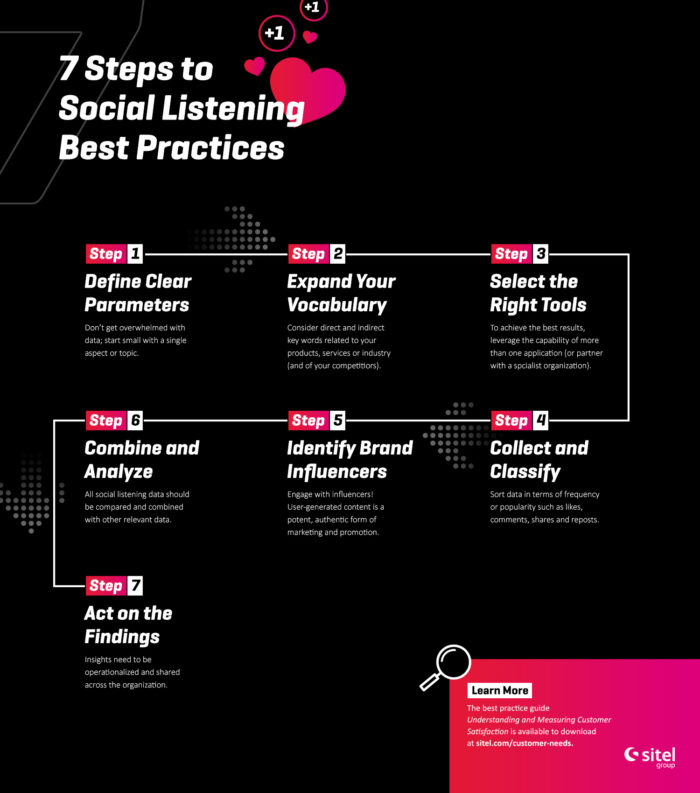Every organisation wants to attract a larger audience while retaining its existing customers. However, as competition increases across all industries, and as consumers become digital by default, traditional approaches to marketing and promotion are being reevaluated. Today, word of mouth – turning loyal customers into advocates – is becoming the most powerful and authentic means of attracting customers to a brand.
This digital aspect of daily life is why tools such as social media listening are key to increasing customer advocacy.
Across social networks, review aggregation sites, blogging platforms, mainstream and specialist media, a conversation about your brand is taking place. Statements are being made, opinions are expressed, information is being shared and connections are forged. Consumers are articulating their frustration about the elements of customer experience which are their pain points.
Others are explaining what makes them loyal to one brand over another and calling out the products and services they like and dislike most – and the reasons why. But if you scratch beneath the surface, consumers are also providing insights into how products or services could be improved. They are also revealing the motivations behind their customer needs and expectations.
They’re expressing what types of marketing and publicity rings true with them and what misses the mark. They are also providing brands information on their interests and other aspects of their lives, such as causes and subjects about which they feel passion and a sense of identity.
All of this information is simply too valuable for an organisation to ignore. Meeting the needs expressed online and addressing inadequacies across the customer journey will turn one-time customers into long-term customers. It can also convert loyal customers into brand advocates.
And it all starts with social listening.
What Is Social Listening?
Social listening – often also referred to a social media listening – is actively following all discussions across the major social networks relating not only to an organisation’s brand, but also to the entire industry in which it operates.
When properly executed and supported with the right tools, processes and methodology, social listening delivers powerful insights regarding how customers feel about an individual brand and its products and services, how consumer trends or behaviours are evolving and how wider industry or sector-level changes are influencing customer expectations.
How Does Social Listening Improve Customer Experience?
Social listening enables an organisation to both hear and analyse every positive and negative conversation openly taking place via social channels about, potentially, any aspect of its operations (not to mention those of its competitors). Social listening is a powerful, cost-effective tool that should be central to business operations.
Whether it’s identifying paint points, underperforming channels or aspects of customer service that customers really appreciate, social listening has become a proven approach for understanding and, as a result, improving any aspect of customer experience. What’s more, social listening can identify brand influencers, capitalise on customer loyalty and, in doing so, turn that loyalty into customer advocacy.
What Are the Benefits of Social Listening?
Perhaps the best aspect of social listening is that it gathers insights based on data being freely offered by consumers across all demographic groups. With social listening, there is no need to design and deploy customer feedback surveys or launch a Voice of the Customer (VOC) program (though both are valuable processes for any organisation focused on long-term customer satisfaction and business growth). Social listening is robust, unsolicited and usually uncensored feedback and in large volumes.
However, this also makes this treasure trove of data equally valuable to all organisations within the same vertical. All brands need to presume their closest competitors are already deploying social listening and reaping the benefits. Therefore, it’s paramount to follow suit.
What’s the Difference Between Social Monitoring and Social Listening?
Though related, social monitoring and social listening are not the same thing. Social monitoring should already be a key operational aspect for any organisation that has a social media presence and uses social channels as part of an omnichannel approach to customer experience.
Social monitoring can be viewed as a metric, like customer satisfaction (CSAT) or Net Promoter Scores (NPS). It normally involves tracking specific hashtags and key words alongside direct brand mentions to measure the ‘buzz’ around an organisation and to look for moments when direct customer engagement is necessary.
For instance, social monitoring will flag if a brand or product is trending for the wrong reasons. Then, an organisation can step in and engage directly to change the narrative and become part of the conversation and solution – instead of the brunt of it.
Likewise, if customers are complaining in large numbers about a specific brand experience, social monitoring will indicate it’s time to reach out to those customers to understand their concerns and to be seen to be taking steps to rectify the situation.
Social monitoring also helps capitalise on the positive, alerting customer experience and marketing departments when conversations around the brand are overwhelmingly positive. They can then take the opportunity to respond and demonstrate appreciation.
As a result, albeit on a one-to-one basis, social monitoring can also be deployed to increase customer advocacy
Social Monitoring Is Reactive, Social Listening Is Proactive
Unlike social monitoring, social listening is more comprehensive in scope and empowers an organisation to take the initiative. It monitors more than direct brand mentions and hashtags. Instead, social listening tracks all conversations relative to a topic of discussion, to an industry sector and to a particular brand and its direct competition. Another big difference between social listening and social monitoring is the fact that the data captured is carefully combined with an organisation’s internal data sources. This data is analysed to provide insights that will aid in business decision making. With a wider understanding of the business landscape, as well as an organisation’s position within it, large-scale improvements can be made to customer experience (CX) that will delight a large percentage of the customer base. This in turn will lead to an amplified word of mouth as more customers advocate for a brand because its CX has become noticeably better.
So, the benefits are clear, but what is the best practice approach to social listening?
The Best Practice Approach to Social Listening

Step 1: Define Clear Parameters
Unless an organisation already has the capacity and expertise needed to collect, process and effectively analyse the breadth and depth of data that can be captured through social listening, systems and teams could be overwhelmed. Likewise, if the processing and analysis of data takes too long, any insights captured will not be timely.
For this reason, it’s best practice to begin with a pilot project focused on a single aspect of the organisation or one potential topic. In addition to delivering initial insights that prove the benefits of social listening, a pilot will help test internal systems and processes.
Step 2: Expand Your Vocabulary
Even with a restricted scope, do not be tempted to limit the number of search terms or data points to track. This could result in capturing data with too narrow a focus to deliver actionable insights or place the findings in context.
Therefore, consider key words that are both directly and indirectly related to products or services or the industry as a whole. Likewise, incorporate hashtags and terms relating to direct competitors. It also pays dividends to actively monitor both the mainstream and specialist media as the major areas of discussion will provide further terms of reference for potential keywords or topics for analysis.
Step 3: Select the Right Social Listening Tools
There is a growing selection of powerful tools and applications from leading specialists on the market that can simply the acts of both social listening and social monitoring. Some excel at analysing review aggregation and video content, some are dedicated to traditional social network analysis and others simplify the task of collaborating across multi-discipline teams.
To achieve the best results, it could be necessary to leverage the capability of more than one application. For this reason, particularly for larger brands, it’s best practice to engage a specialist organisation that can help design the scope of social-listening projects and conduct the necessary due diligence required to identify and apply the right tools for optimum results.
Step 4: Collect and Classify
Before the data collected through social listening is properly analysed, it needs to be classified within a number of overarching categories. These categories can be used like metrics to provide an initial understanding. The first classification, or metric, is sentiment. Are the majority of discussions, comments and posts that directly reference the organisation or its products and services positive, neutral or negative?
Data should also be sorted in terms of frequency or popularity. How often are specific terms showing up and do any stand out in terms of the number of likes, comments, shares or reposts?
Step 5: Identify Brand Influencers
What should quickly become apparent as the raw data is processed is that some consumers have a louder voice than others. Their posts or commentary attract much more attention, and this means they have a greater influence regarding how an organisation’s brand is perceived. User-generated content is an extremely potent and authentic form of marketing and promotion. Therefore, identifying and engaging with influencers is good for business.
Step 6: Combine and Analyse
All data harvested from social listening should be compared and combined with any relevant data within the organisation. This includes customer histories sitting within the CRM, to call logs, metrics and other data collected through contact centres or direct customer interactions.
Again, even if this is a pilot project, the blending of different types and different data formats can present challenges – especially if that data sits across multiple systems within the organisation.
Therefore, expert assistance can prove invaluable. As well as developing processes that can funnel all data together, if that partner possesses a deep enough understanding of the specific industry, they can oversee the subsequent data analysis and draw out the right insights.
Step 7: Act on the Findings
Insights need to be operationalised and shared across the organisation. Taking steps to move closer to the customer is a process that requires everyone in an organisation to engage based on the findings of any form of detailed customer feedback – not only social listening.
Social listening can create stronger customer relationships, provide a deeper, more rounded view of a brand’s addressable audience and help improve any aspect of customer experience delivery. Furthermore, social listening can boost the effectiveness of marketing campaigns, lower customer acquisition and retention costs by increasing customer advocacy and empower organisations to become active participants in the conversation around their brand.

